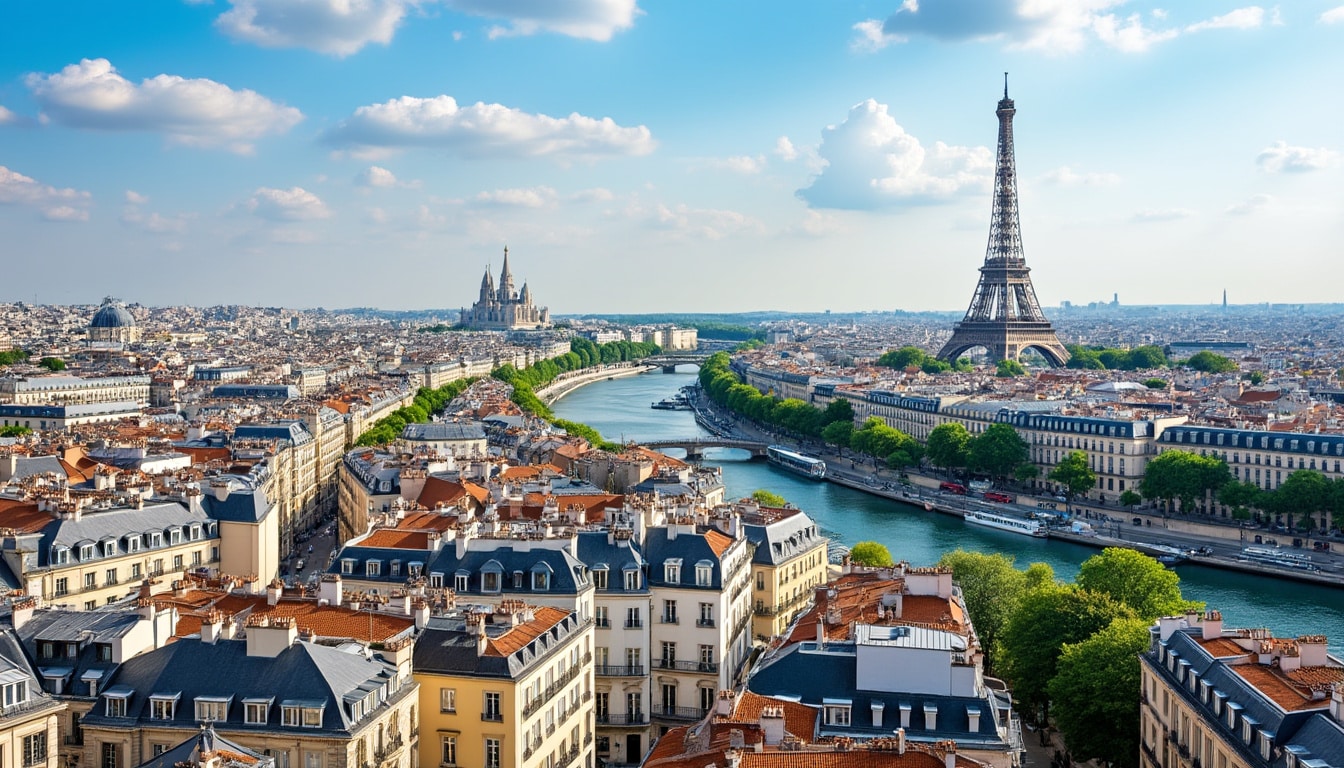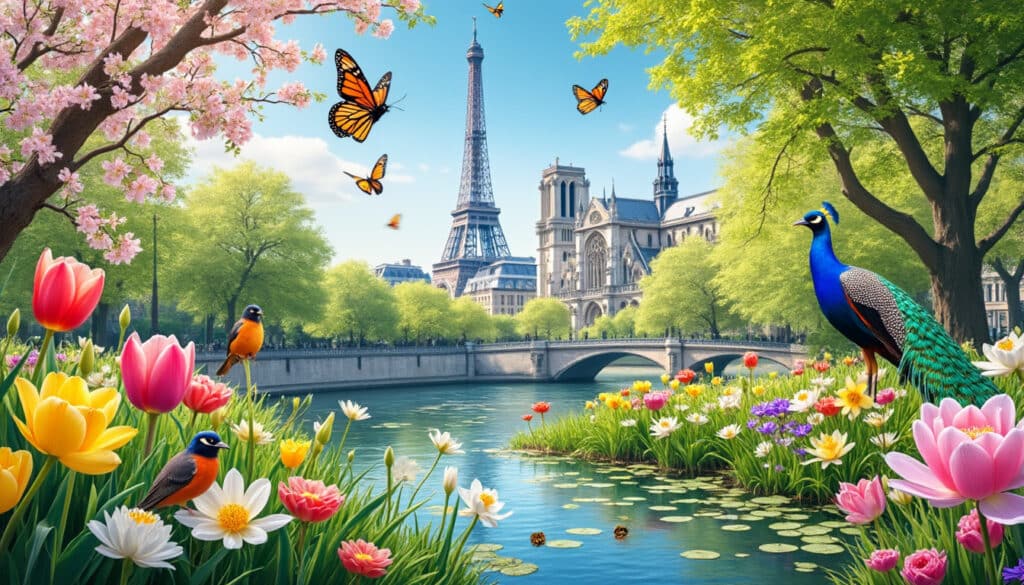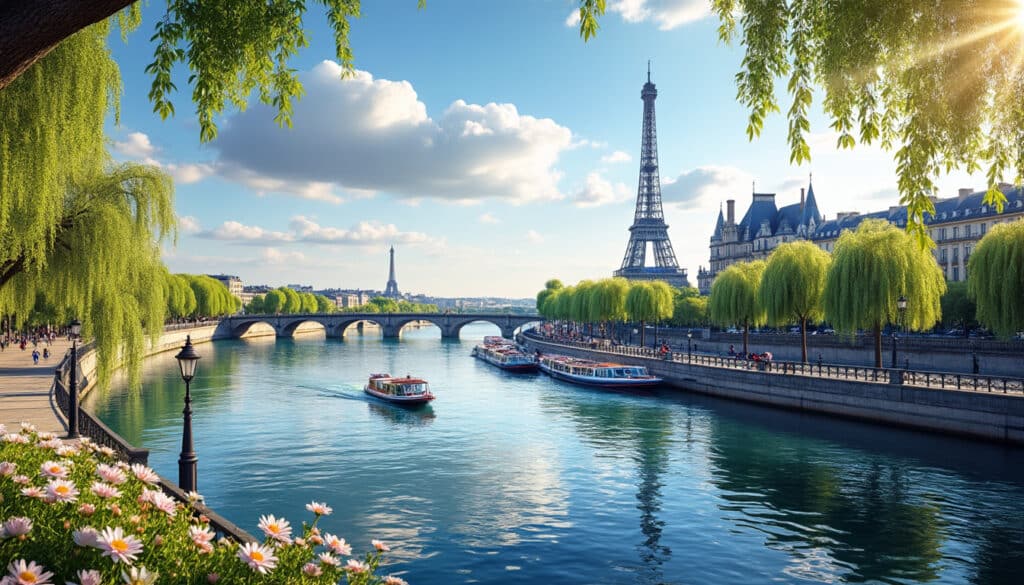Paris, the “City of Light,” is not only known for its iconic landmarks and vibrant culture but also for its remarkable geographical features. From its strategic location on the River Seine to the charming islands within its heart, Paris offers a unique blend of natural beauty and urban elegance. The city’s historical buildings further illustrate its rich past, with structures that stand as testaments to its architectural and cultural legacy. Exploring these physical attributes reveals a deeper understanding of what makes Paris a true gem in the landscape of global cities.
The Strategic Geography of Paris and Its Environs
Paris’ geographical significance is largely attributed to its location on the River Seine. This river not only provides a scenic backdrop for the city’s architectural marvels but also serves as a critical natural resource. The city is situated on a mostly flat coastal plain, which is surrounded by hills such as Montmartre, offering both aesthetic and strategic advantages. The area is part of a sedimentary basin, which historically facilitated trade and movement, giving Paris a vital role in European commerce.

Paris’ geography is marked by the two natural islands – Île de la Cité and Île Saint-Louis. These islands are pivotal to Paris’ formation and growth, serving as the historical heart of the city. Île de la Cité, home to iconic landmarks like the Notre-Dame Cathedral and Sainte-Chapelle, highlights the medieval roots of the city. The islands are integrated into the city via numerous bridges, making them easily accessible and adding to the cityscape’s charm.
The city’s geographical features also extend to its modern urban layout. Paris is divided into 20 arrondissements, creating a spiral shape through the city. This unique division provides structure and organization, enhancing the flow of both residents and tourists throughout the city’s expansive area of 105 square kilometers.
Moreover, Paris benefits from its nearby natural landscapes, including the famous vineyards and forests just outside the city’s limits. These green spaces offer a glimpse into the lush countryside atmosphere that once surrounded the entire city. Additionally, the city’s close proximity to other major European metropolises underscores its importance as a central hub in the continent’s economic and cultural networks.
These geographical factors not only define the aesthetics and layout of Paris but also influence its climate, infrastructure, and living conditions. The combination of natural and urban settings creates a harmonious balance that has been maintained and celebrated for centuries. This rich tapestry of land and water forms the foundation upon which Paris’ cultural and historical treasures are built.
The Charm of Île de la Cité and Île Saint-Louis
The islands of Île de la Cité and Île Saint-Louis are integral to Paris’ geographical charm, serving as epicenters of history and culture. Nestled in the River Seine, these islands provide a unique opportunity to step back in time while still being in the heart of a bustling metropolis. They are famous not only for their beauty but also for their timeless architecture and vibrant atmosphere.
Île de la Cité is often regarded as the cradle of Parisian civilization. This island is renowned for its medieval structures, which include the breathtaking Notre-Dame Cathedral, the Concierge Prison, and the Louis IX Sainte-Chapelle. These buildings are not merely tourist attractions; they are living relics from different eras that tell stories of the city’s rich history and evolution through the ages.
The island’s central location has always made it a strategic site, a place of power from the days of the Roman settlement to the modern French Republic. Today, it continues to be a vibrant center for both locals and tourists alike, offering a plethora of cafes, bookstores, and souvenir shops that line its narrow streets.
In contrast, its neighbor, Île Saint-Louis, represents the quieter, more residential side of island life in Paris. Known for its elegant townhouses and quaint boutiques, Île Saint-Louis is a haven for those seeking a more tranquil experience. Here, the leisurely pace allows for intimate exploration of its historic charm, with stunning views of the River Seine from nearly every corner.
- 🏛️ Iconic landmarks: Notre-Dame Cathedral, Sainte-Chapelle
- 🏡 Residential charm: Elegant townhouses on Île Saint-Louis
- 🍽️ Delightful eateries: Quaint cafes and restaurants
The two islands together symbolize the dual nature of Paris—its ability to be simultaneously grand and intimate, historic and contemporary. They underscore the city’s dedication to preserving its heritage while embracing modernity. The islands’ strategic bridges connect them seamlessly to the rest of the city, each offering a spectacular view that amplifies the majestic nature of Paris’ scenery.
Overall, the islands are examples of timeless beauty embedded in the daily life of a modern world. They continue to captivate the hearts of those who visit, offering unique opportunities for discovery and wonder right in the heart of Paris. These islands remain foundational to understanding the city’s geographic allure.
The Integral Role of the River Seine in Paris
The River Seine is quintessentially linked to the identity of Paris. Flowing through the heart of the city, this major waterway not only enhances its beauty but also plays a significant role in its development and daily life. The banks of the Seine are lined with some of Paris’ most famous landmarks, offering scenic views that have inspired countless artists and writers over the years.
The Seine is a favorite spot for both locals and tourists alike, offering opportunities for romantic walks, picnics, and boat cruises. These cruises provide an unparalleled view of the city from the water, passing under Paris’s beautiful bridges including the famed Pont Neuf and the modern Pont Charles de Gaulle. This unique perspective is not just idyllic but offers insights into the architectural marvels and urban planning that characterize Paris.
In addition to its aesthetic and recreational value, the Seine has practical significance as well. Historically, it was a vital trade route, and today it still supports commercial conveyance as well as tourism and leisure activities. The river’s banks serve as a meeting point for many of Paris’s activities, from bustling markets to lively cultural events.
| Bridges of Paris | Year Completed | Significance 🌉 |
|---|---|---|
| Pont Neuf | 1607 | Oldest bridge, connects Île de la Cité |
| Pont Alexandre III | 1900 | Decorative, near Grand Palais |
| Pont Charles de Gaulle | 1996 | Modern design, connects Austerlitz area |
The transformation of the Seine’s banks into pedestrian-friendly areas has further enhanced its appeal. These developments reflect an ongoing commitment to making the Seine accessible and enjoyable for all, reinforcing its role as a symbol of Paris’ embrace of both history and progress. This blend of utility and beauty is exactly what defines the river’s place within the city.
From sunrise to sunset, the River Seine remains a bustling artery in the Parisian landscape, brimming with life and activity. Whether it’s the quiet solitude of early morning reflections or the vibrant energy of nighttime illuminations, the Seine is a constant reminder of the enduring romance and dynamic vibrancy of Paris.
The Architectural Symphony of Historical Buildings in Paris
Paris is an architectural treasure trove, with historical buildings scattered throughout the city that offer insights into its illustrious past. The fusion of gothic, renaissance, and modern architectural styles reflects the evolution of tastes and technologies over centuries, each adding layers to Paris’ captivating story.
Notre-Dame Cathedral stands as a testament to gothic architecture with its stunning façade and intricate interiors, while the Louis IX Sainte-Chapelle impresses with dazzling stained-glass windows. Such landmarks are not mere relics but active participants in the cultural and social life of Paris, drawing millions of visitors from all around the world.
Not far from these monuments lies the Louvre, once a royal palace and now the world’s largest art museum. Its glass pyramid entrance, added in the late 20th century, exemplifies the harmonious blending of traditional and modern aesthetics, illustrating the city’s ability to innovate while honoring its past.
The monumental Bastille and surrounding areas symbolize revolutionary spirit and transformation. In the nearby Latin Quarter, institutions like the Sorbonne University underscore the city’s long-standing commitment to education and enlightenment.
- 🏰 Notre-Dame: Gothic architecture masterpiece
- 🖼️ Louvre: World’s largest art museum
- 🚩 Bastille: Revolution’s heart
Another iconic structure, the Sacré-Cœur, perched atop Montmartre, offers panoramic views of the city. It presents a stunning contrast with the Trocadéro, across from the Eiffel Tower, which showcases classical styles amid the modern structures around it. Such sites bring together the rich tapestry of Paris’ architectural prowess.
These impressive structures are more than just buildings; they are integral to the city’s identity and narrative. They serve as emblems of France’s historical might and artistic innovation, offering a unique and picturesque landscape that bridges the past with the future.
Each building in Paris tells its own story, woven into the larger narrative of the city’s evolution. They stand as tributes to the architects, artisans, and visionaries who shaped this remarkable city. Through them, one can witness the grandeur and complexity of Paris that continues to enchant and inspire.
The Role of Paris in Contemporary Geography and Economics
Paris’ geography doesn’t solely influence its physical landscape but also its economic and cultural dynamics. As an epicenter of fashion, art, and gastronomy, Paris attracts millions of tourists, scholars, and professionals every year, reinforcing its role as a global city.
The Champs-Élysées, a symbol of luxury and grandiosity, embodies this cultural magnetism. From high-end fashion houses to diverse dining experiences, the boulevard is a testament to Paris’ global appeal. The presence of international headquarters enhances its status as a limelight of business and innovation.
Furthermore, the Trocadéro and surrounding areas, renowned for cultural and artistic events, contribute significantly to Paris’ economy. The seamless blend of historical sites and modern enterprises fosters an environment where tradition and innovation coalesce, propelling the city to new heights.
Paris’s location as a transport hub in Europe, linked by intricate networks of rail and road, strengthens its economic hold. The proximity to international trade routes and rapid rail connections plays a crucial role in Paris’ accessibility and economic productivity.
| Key Economic Sectors | Activities ⚙️ |
|---|---|
| Fashion | Luxury brands, fashion weeks |
| Tourism | Museums, historical sites, cuisine |
| Technology | Innovative startups, tech events |
Despite its urban density, Paris maintains green spaces that offer a respite from city life. The integration of parks and gardens throughout the city enhances its livability and appeal, contributing to its reputation as a city that embraces sustainability and well-being.
In essence, Paris exemplifies how geography can influence and shape a city’s economic and cultural landscape. It remains a focal point for global dialogue, attracting diverse talents and fostering an environment where ingenuity thrives. This endows Paris with an unrivaled character—a world city that not only preserves its heritage but continually reinvents itself for the future.
FAQ: Understanding Paris’ Geographical Features
- Why is the River Seine important to Paris? 🚤
- The River Seine is vital for both its scenic beauty and practical use in commerce, tourism, and transportation.
- What role do Île de la Cité and Île Saint-Louis play in Paris’ history? 🏝️
- They are historical islands that served as the foundational center of Paris, home to many iconic structures like Notre-Dame.
- How does Paris’ geography influence its economy? 💼
- Paris’ central location in Europe has made it a hub for commerce and innovation, impacting sectors like fashion, technology, and tourism.

When one thinks of Paris, visions of the iconic Eiffel Tower, charming street cafés, and exquisite cuisine might instantly come to mind. Yet, beneath its cultural richness lies a fertile tapestry of landscapes that intricately shape this vibrant metropolis. From…

Location and coordinates of Paris
Paris, known for its unparalleled beauty and rich history, is a city that captures the imagination of millions around the world. From iconic landmarks like the Eiffel Tower to charming cobbled streets and vibrant art scenes, Paris is a destination…

Paris, the City of Light, is not just famous for its stunning architecture and exquisite gastronomy; it’s also home to a vibrant mosaic of parks and green spaces. These offer both residents and visitors a chance to escape the urban…


